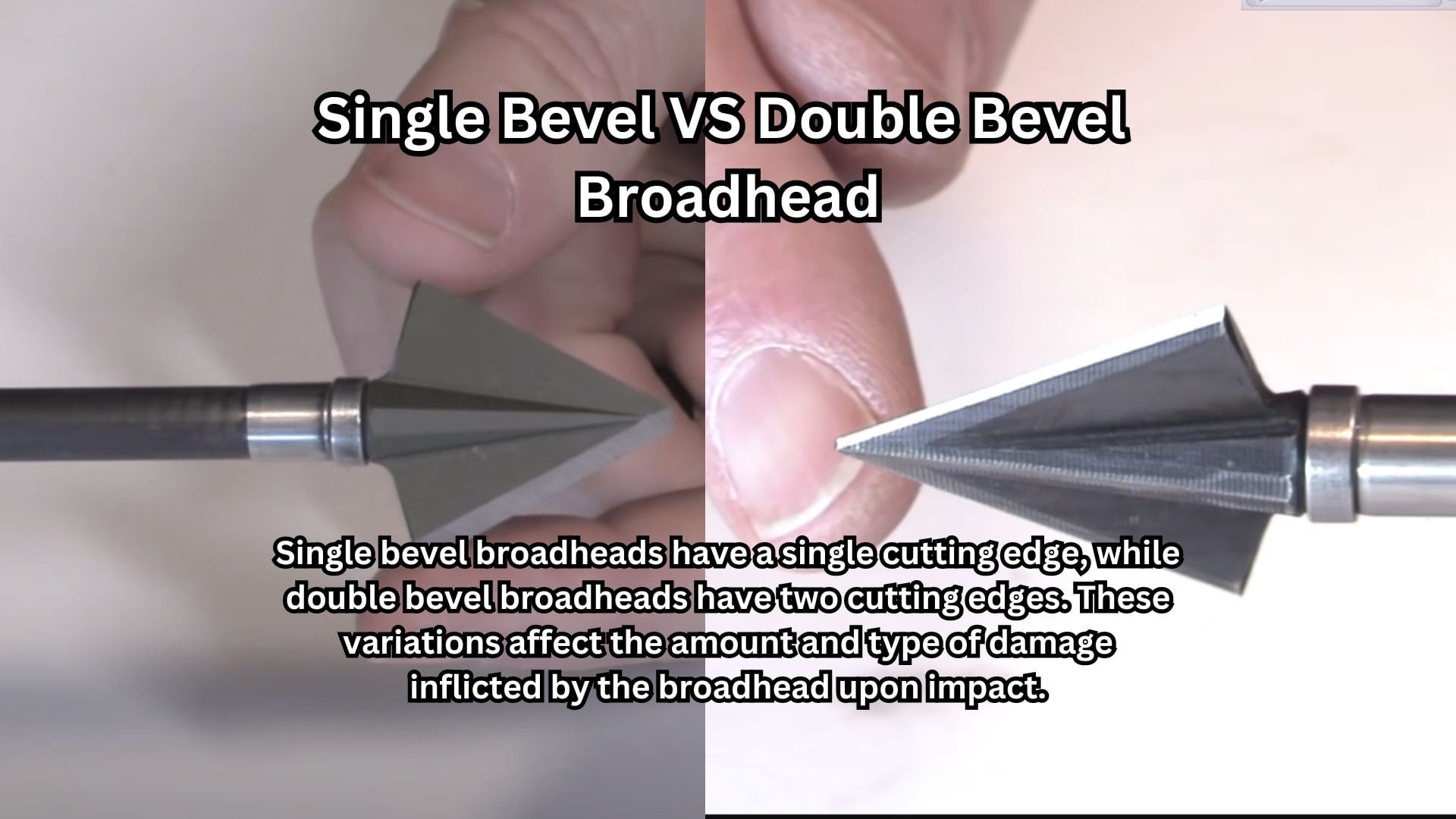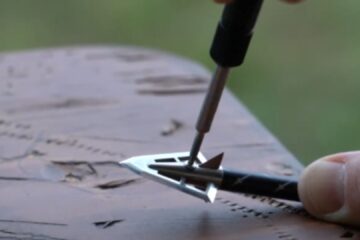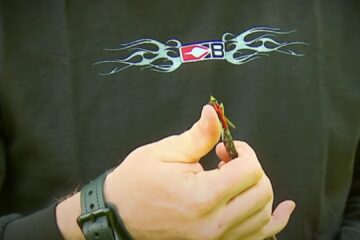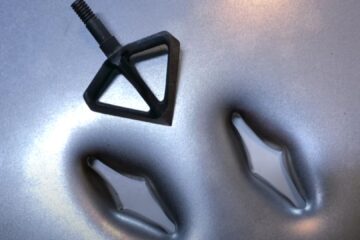Single bevel broadheads have a single cutting edge, while double bevel broadheads have two cutting edges. These variations affect the amount and type of damage inflicted by the broadhead upon impact.
Single bevel broadheads tend to create more rotational force, resulting in deeper penetration and increased tissue damage. Double bevel broadheads, on the other hand, offer better flight stability and accuracy due to their symmetrical design. The choice between single and double bevel broadheads ultimately depends on the hunter’s preference and hunting conditions.
Consider factors like target size, hunting distance, and desired level of penetration before selecting the most suitable broadhead for your needs.
Design And Construction
Single bevel and double bevel broadheads are both popular choices in archery. The design and construction of these broadheads determine their performance and effectiveness. Each has its advantages, and understanding the differences can help you make an informed decision when selecting the right one for your hunting or shooting needs.
When it comes to choosing the right broadhead for your hunting needs, the design and construction of the blade are crucial factors to consider. Both single bevel and double bevel broadheads have their own unique features and advantages. In this section, we will explore the blade configuration and angle, the material used, as well as the advantages and disadvantages of each type.
Blade Configuration And Angle
Single Bevel Broadhead:
- Single bevel broadheads have a blade configuration that features only one bevel edge.
- The bevel edge of a single bevel broadhead is angled on one side, while the other side remains flat.
- This design helps the broadhead rotate in flight, resulting in increased stability and accuracy.
- The single bevel angle creates a spiraling effect during penetration, enhancing the cutting power and se
Mechanics Of Single Bevel Broadheads
Single bevel broadheads offer a unique advantage over double bevel broadheads with their asymmetrical design, providing increased penetration and better stability during flight. These mechanics result in improved accuracy and enhanced tissue damage for a more effective hunting experience.
When it comes to single bevel broadheads, their unique design and mechanics play a crucial role in their performance. Let’s delve into the mechanics of single bevel broadheads and explore their key features:
Penetration Ability:
Single bevel broadheads offer exceptional penetration ability due to their asymmetric design. Here’s why:
- Chisel Point: The chisel point of the single bevel broadhead features one beveled edge, which allows it to break through tough hide and bone with ease.
- Angular Deflection: The angled cutting surface of the broadhead creates a wedging effect, redirecting tissue and creating larger wound channels.
- Enhanced Tip Strength: The single bevel design concentrates force on a smaller area, making the tip of the broadhead stronger and more resistant to deflection during impact.
Spin And Stability:
Spin and stability are crucial factors for accurate arrow flight and effective broadhead performance. Single bevel broadheads excel in this area:
- One-Sided Spin: The single bevel design causes the arrow to spin on a single axis, promoting stability and reducing the likelihood of arrow planing during flight.
- Gyroscopic Stabilization: The spinning motion generated by the single bevel broadhead enhances gyroscopic stabilization, improving accuracy and consistency.
- Optimal Alignment: As a single bevel broadhead spins, it aligns itself with the direction of travel, minimizing side-to-side movement and maintaining a straight trajectory.
Wound Channel Size And Shape:
The wound channel created by a broadhead impacts both the blood trail and the overall effectiveness of the shot. Single bevel broadheads offer unique characteristics in this regard:
- Deeper Penetration: The angled bevel of a single bevel broadhead allows for deeper tissue penetration, reaching vital organs and increasing the likelihood of a quick, humane kill.
- Conical Wound Channel: Single bevel broadheads create a conical wound channel due to their angled cutting edge. This shape maximizes blood loss, aiding in tracking wounded game.
- Tissue Disruption: The asymmetric design of a single bevel broadhead promotes tissue disruption by causing the broadhead to rotate in the wound, creating additional damage and increasing the chances of a clean kill.
The mechanics of single bevel broadheads provide distinct advantages in terms of penetration ability, spin and stability, and wound channel size and shape. These broadheads are designed to maximize arrow performance, ensuring a higher chance of success during hunts.
Use Cases And Effectiveness
Single bevel and double bevel broadheads have different use cases and levels of effectiveness. The choice between the two depends on factors like hunting style, arrow flight, and desired cutting performance for optimum results in the field.
The use of single bevel and double bevel broadheads is a topic of discussion among hunters and archery enthusiasts. Understanding the use cases and effectiveness of each type is crucial in making an informed choice. In this section, we will delve into the specific scenarios where these broadheads excel, their advantages, and how they compare to other types.
Hunting Small Game:
- Single bevel broadheads are highly effective for hunting small game due to their unique design.
- The single bevel edge creates a spiraling effect upon impact, resulting in deeper penetration and better tissue damage.
- This makes them ideal for hunting animals such as rabbits, squirrels, and birds.
- The rotation caused by the single bevel blade ensures maximum damage, increasing the chances of a clean and successful kill.
Target Shooting:
- Both single bevel and double bevel broadheads are suitable for target shooting.
- Single bevel broadheads can help improve accuracy and consistency in long-range shots due to their stabilizing effect during flight.
- On the other hand, double bevel broadheads offer a wider cutting diameter, making them easier to hit the target, especially for beginners.
- When it comes to target shooting, the choice between single bevel and double bevel broadheads often depends on personal preference and shooting style.
Comparison To Other Broadhead Types:
- Single bevel broadheads have an advantage over fixed blade and mechanical broadheads in terms of penetration and durability.
- The angled single bevel design acts like a chisel, providing better bone-breaking capability.
- On the other hand, double bevel broadheads offer a larger cutting surface area, resulting in more significant wound channels and increased blood loss.
- Compared to expandable broadheads, both single bevel and double bevel broadheads are generally more reliable, as they do not rely on mechanical components that may malfunction.
- Ultimately, the choice between single bevel and double bevel broadheads depends on the specific hunting situation, personal skill level, and preferences of the archer.
Single bevel and double bevel broadheads have their unique use cases and effectiveness. While single bevel broadheads excel at hunting small game and provide added precision for target shooting, double bevel broadheads offer larger cutting areas. Understanding these differences and comparing them to other broadhead types will help archers choose the right broadhead for their specific needs and preferences.
Mechanics Of Double Bevel Broadheads
Double bevel broadheads utilize two blades that are sharpened on both sides, resulting in enhanced cutting power and better flight accuracy compared to single bevel broadheads.
Single bevel and double bevel broadheads, both have their advantages and mechanics worth considering. In this section, we will delve into the mechanics of double bevel broadheads and explore their impact on penetration ability, accuracy and precision, as well as blood trail and game recovery.
Penetration Ability:
Double bevel broadheads offer certain advantages when it comes to penetration ability. Consider the following:
- Dual cutting edges: One of the key mechanics of double bevel broadheads is the presence of two cutting edges. This design allows for increased tissue damage and better penetration through the game.
- Enhanced slicing action: With two cutting edges converging towards the point, double bevel broadheads create a slicing action upon impact. This enables better penetration through tough hide and bones, resulting in deeper wound channels.
- Reduced deflection: The symmetric design of double bevel broadheads minimizes the chances of deflection upon contact with bones or other obstacles. This leads to improved penetration and ultimately better performance in the field.
Accuracy And Precision:
When it comes to accuracy and precision, the mechanics of double bevel broadheads play a crucial role. Consider the following aspects:
- Balanced flight characteristics: Double bevel broadheads are known for their balanced flight characteristics. The symmetric design and equal weight distribution contribute to better aerodynamics, resulting in improved accuracy and consistent arrow flight.
- Reduced wind drift: The symmetric cutting edges of double bevel broadheads help minimize wind drift during flight. This allows for more precise shot placement, especially in challenging wind conditions.
- Consistent impact: The interaction of both cutting edges upon impact ensures consistent arrow orientation and reliable penetration. This predictability contributes to overall shot accuracy and increased precision.
Blood Trail And Game Recovery:
The mechanics of double bevel broadheads can also have an impact on blood trail and game recovery. Consider the following points:
- Expanded wound channels: Two cutting edges working in tandem create larger wound channels, resulting in increased blood flow and a more pronounced blood trail. This aids in tracking and locating the harvested game.
- Improved tissue damage: Double bevel broadheads have a higher probability of causing extensive tissue damage compared to their single bevel counterparts. This not only enhances the blood trail but also increases the chances of a clean and ethical kill.
- Efficient game recovery: The combination of deep penetration, consistent impact, and a clear blood trail offered by double bevel broadheads contributes to more efficient game recovery. This results in reduced tracking time and increased success rates.
The mechanics of double bevel broadheads provide advantages in terms of penetration ability, accuracy and precision, as well as blood trail and game recovery. These broadheads with their dual cutting edges and symmetric design offer improved tissue damage, enhanced flight characteristics, and increased wound channels.
Ultimately, understanding these mechanics can help bowhunters make an informed decision when selecting broadheads for their hunting needs.
Factors To Consider
When choosing between a single bevel and double bevel broadhead, factors such as cutting ability, stability, and accuracy should be considered. The single bevel broadhead offers better penetration and bone-splitting ability, while the double bevel broadhead provides enhanced stability and flight performance.
Carefully weighing these factors will aid in making the right choice for your hunting needs.
When deciding between a single bevel and a double bevel broadhead, there are several important factors to consider. Understanding these factors can help you make an informed decision based on your hunting needs and preferences. Below, we delve into three key considerations that can help guide your choice: hunting game size and type, shooting style and distance, and personal preference and experience.
Hunting Game Size And Type:
- Different game sizes and types require different broadhead designs to ensure optimal performance and ethical harvests.
- Single bevel broadheads are known for their exceptional penetration and bone-breaking capabilities, making them well-suited for larger game such as elk, moose, or bear.
- On the other hand, double bevel broadheads offer superior cutting surface area, making them ideal for smaller game like deer, turkey, or antelope.
- Consider the size and toughness of the animals you plan to hunt, and choose a broadhead type that is designed to match their characteristics.
Shooting Style And Distance:
- Your shooting style and the distances at which you typically take your shots will also impact your choice between a single bevel and a double bevel broadhead.
- Single bevel broadheads have a natural tendency to spin upon impact, making them more forgiving for shooters with inconsistent form or shooting at longer distances.
- If you prefer to shoot from a longer distance or have a shooting style that needs more stabilization, a single bevel broadhead may be the better option due to its increased accuracy.
- Conversely, double bevel broadheads are known for their exceptional flight and accuracy at closer distances and for shooters with consistent form.
Personal Preference And Experience:
- Your personal preference and experience should not be overlooked when making a decision between single bevel and double bevel broadheads.
- Some hunters may have experience and comfort with one broadhead type over the other, which can influence their choice.
- Additionally, it is essential to consider any learning curve associated with using a particular broadhead design. If you have never used a single bevel or double bevel before, it may require some practice to get accustomed to the new design.
- Take into account what you feel comfortable shooting with and what aligns with your past successes and preferences.
When deciding between single bevel and double bevel broadheads, it is important to consider factors such as hunting game size and type, shooting style and distance, as well as personal preference and experience. By carefully evaluating these factors, you can choose the broadhead design that best suits your hunting needs and maximizes your chances for success in the field.
Testing And Experimentation
Testing and experimentation reveal crucial differences between single bevel and double bevel broadheads. Discover which one stands out for your archery needs.
Broadheads play a crucial role in the success of any bowhunting endeavor. When it comes to choosing between a single bevel and a double bevel broadhead, testing and experimentation can provide valuable insights into their performance. Here, we’ll explore three key aspects: accuracy tests, penetration tests, and wound channel analysis.
Accuracy Tests:
Shooting accuracy is one of the most important factors to consider when selecting a broadhead.
Here are some points to consider:
- Weight distribution: Single bevel broadheads tend to have a front-heavy design, which can impact arrow flight. On the other hand, double bevel broadheads have a more balanced weight distribution, potentially improving accuracy.
- Flight consistency: Both single and double bevel broadheads can offer good flight consistency when properly tuned. However, individual bow setups and shooting techniques can affect arrow flight differently with each type.
- Tuning adjustments: Depending on your shooting setup, you may need to make tuning adjustments to optimize the accuracy of either broadhead type.
- Field testing: Conducting real-world field tests can provide practical insights into the accuracy of single and double bevel broadheads. Factors such as distance, wind conditions, and shot placement should be taken into account to get accurate results.
Penetration Tests:
The ability of a broadhead to penetrate an animal’s hide and tissues is crucial for ethical hunting.
Consider the following:
- Cutting diameter: Single bevel broadheads often have larger cutting diameters, which can result in deeper penetration. Conversely, double bevel broadheads with smaller cutting diameters may offer better penetration on hard-bodied game.
- Blade thickness and angle: Blade thickness and angle affect the penetration potential of a broadhead. Thin, sharp blades can provide better penetration, while steep blade angles may enhance the bone-breaking ability of a broadhead.
- Animal size and shot placement: Penetration can also be influenced by the size of the animal being hunted and the shot placement. Testing broadheads on various sizes of game animals and different shot angles can give valuable insights into their performance.
- Comparative testing: Performing side-by-side penetration tests using both single and double bevel broadheads on ballistic gel or other penetration mediums can offer a reliable basis for comparison.
Wound Channel Analysis:
The wound channel created by a broadhead affects blood loss and the overall effectiveness of the shot.
Consider the following:
- Cutting efficiency: Single bevel broadheads are known for their ability to create larger wound channels due to their unique cutting action. Conversely, double bevel broadheads may create narrower but deeper wound channels.
- Hemorrhage potential: The extent of blood loss caused by a broadhead’s wound channel can impact the tracking and recovery of the animal. Experimentation can help determine the effectiveness of both single and double bevel broadheads in promoting hemorrhaging.
- Comparative analysis: Comparing the wound channels created by single and double bevel broadheads through field tests or controlled experiments can shed light on their relative effectiveness.
Testing and experimentation are valuable approaches when comparing single and double bevel broadheads. By conducting accuracy tests, penetration tests, and wound channel analysis, you can make a well-informed decision about which broadhead type best suits your bowhunting needs.
Experts’ Opinions And Recommendations
Experts’ opinions and recommendations on the debate between single bevel and double bevel broadheads can provide valuable insights for hunters. By analyzing various factors such as penetration power, accuracy, and durability, experts help hunters make an informed decision. Whether opting for the single bevel or double bevel broadhead, considering expert advice can greatly impact hunting success.
Insights From Experienced Hunters And Archers:
- Broadheads come in two types: Single bevel and double bevel. To get a deeper understanding of the differences between the two, we reached out to seasoned hunters and archers for their opinions and recommendations. Here’s what they had to say:
1. Penetration And Wound Channel
Single bevel broadheads:
- Better at penetrating game due to the asymmetric cutting edges.
- Tend to create wider wound channels, resulting in greater blood loss and easier tracking.
- Particularly effective on large game like elk or bear.
Double bevel broadheads:
- Offers more symmetrical cutting surfaces, leading to balanced penetration.
- Can create narrower wound channels, making tracking slightly more challenging.
- Preferred by hunters pursuing smaller game, such as deer or turkey.
2. Cutting Efficiency And Bone Breaking
Single bevel broadheads:
- Known for their exceptional cutting efficiency and bone-breaking capabilities.
- The angled blade design provides a slicing motion, which can improve the broadhead’s ability to break through bones.
- Highly recommended for hunters targeting heavily muscled animals like boars.
Double bevel broadheads:
- Offer reliable cutting performance and are easier to sharpen.
- Less likely to deflect upon hitting bone compared to single bevel broadheads.
- Ideal for hunters who prioritize easy maintenance and versatility in various hunting scenarios.
Preferred Broadhead Types For Specific Scenarios:
Each hunting scenario presents unique challenges and demands specific broadhead characteristics.
Here are some recommendations from experts:
1. Thick Skinned Game And Quartering Shots
Single bevel broadheads:
- Excellent choice for thick-skinned game like boars.
- Well-suited for quartering shots due to their superior bone-breaking ability.
- Provide the necessary penetration to reach vital organs and ensure a successful harvest.
2. Lightly Built Game And Long Range Shots
Double bevel broadheads:
- Preferred for smaller game like deer or turkey.
- Their balanced cutting performance allows for precise shots and clean kills.
- Ideal for hunters who frequently engage in long-range shooting.
Tips For Maximizing Precision:
Regardless of your broadhead choice, precision is crucial for ethical hunting.
Here are some tips to enhance your accuracy:
1. Consistent Shooting Form:
- Maintain a consistent shooting form, including posture, grip, and anchor point.
- Practice regularly to develop muscle memory and hone your shooting technique.
2. Perfecting Your Bow Setup:
- Ensure your bow is properly tuned and the arrow rest is aligned.
- Regularly check for proper arrow spine and broadhead alignment.
3. Broadhead Testing:
- Preliminary broadhead testing helps identify the most accurate and reliable option for your setup.
- Experiment with different broadheads and assess their flight patterns and consistency.
Remember, finding the right broadhead ultimately comes down to personal preference and specific hunting circumstances. Consider the insights shared by experts, but always test and evaluate what works best for you. Happy hunting!
Frequently Asked Questions On Single Bevel Vs Double Bevel Broadhead
What Is A Single Bevel Broadhead And How Does It Work?
A single bevel broadhead is a type of arrowhead with one sharpened edge. When shot at a target, it starts to rotate due to its asymmetrical shape, causing it to cut through the target more effectively.
What Are The Advantages Of Using A Single Bevel Broadhead?
Using a single bevel broadhead offers several advantages. It provides deeper penetration, offers better bone-splitting capabilities, and has better cutting efficiency due to its rotational motion. Additionally, it creates larger wound channels and can be easier to sharpen.
What Is A Double Bevel Broadhead And How Is It Different?
A double bevel broadhead is an arrowhead with two sharpened edges. Unlike the single bevel broadhead, it does not rotate upon impact. Instead, it cuts through the target with both edges simultaneously, providing a wider slicing effect.
What Are The Benefits Of Using A Double Bevel Broadhead?
The main benefits of using a double bevel broadhead include improved flight accuracy and stability. The symmetrical design reduces planning and flight interference, resulting in better accuracy. Additionally, the double edge design increases cutting surface area, enhancing blood trails and overall effectiveness.
Conclusion
After examining the differences between single bevel and double bevel broadheads, it is evident that both options have their own unique advantages. Single bevel broadheads offer superior penetration and bone-breaking capabilities, while double bevel broadheads provide enhanced cutting surfaces for faster and easier blood trails.
Your choice ultimately depends on your personal preferences and hunting style. It’s important to consider the type of game you plan to hunt, the type of bow you are using, and the conditions in which you’ll be hunting. Regardless of your choice, it’s crucial to practice with your broadheads before heading out into the field to ensure accuracy and optimal performance.
Remember to always prioritize accuracy and shot placement over blade design. Happy hunting!






